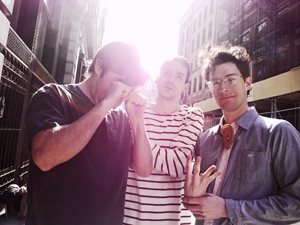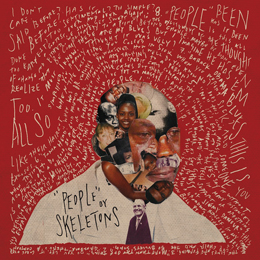Behind the Release: Skeletons' “People”
NEW YORK CITY: For their latest release, Skeletons have stripped back the flesh, eschewing their electronics-based approach to feature artful live performances of challenging new compositions.
Sometimes presenting stretches of sound that are as harrowing and disjointed as his band’s name implies, writer/guitarist/singer Matt Mehlan has struck a difficult balance, developing a sound that is at once mathy and emotive.
Over 40 minutes, People” plays with a sonic theme of chaos and release that Mehlan even suggests verbally on the second track, reminding us that “there is no calm without the storm.”
And the album’s first song stirs up quite a storm: surprisingly “Lil’ Rich” is, perhaps, one of the most distancing cuts on the entire record. An eerie acoustic guitar and haunting narrative give way to layers of relentlessly awkward rhythms and competing incidental sounds that grow out-of-control like unchecked fractals, before evaporating into sparse dissonance once again.
But overall, People isn’t as difficult as the first track might suggest. The album opens up as it goes along, becoming progressively more accessible, and allowing greater order and ear candy into the mix, until it blossoms into something that’s ultimately relatable and inviting to the listener.
In its most elegant moments, Skeletons’ sound takes on a hypnotic minimalism in which ornately-spun guitar lines repeat themselves with a glimmer that brings to mind a rock-and-roll Steve Reich, where circular melodies build to a kaleidoscopic intensity of brightly-ordered chaos.
Track 5, “Tania Head,” stands as a particularly accessible and even-tempered track that showcases the more traditional post-rock influences of bands like Tortoise or The Sea and Cake. However, Skeletons are anything but art-rock rehash. Their sensibilities align with forward thinking contemporaries like Pattern is Movement, Zs and Hubble as well as their recent tour-mates, Dirty Projectors.
THE PROCESS
“This record was more about capturing a band in a room,” says Mehlan. “ Before, we were trying to create the sound of a band, and figure out the arrangements, in the digital realm.”
“On this record the instrumentation is all classic instruments: guitar, bass, drums, horns, some old keyboards. The electronics kind of became ornamental rather than the heart of the track.”
When asked what inspired this change, Mehlan says he “think[s] it comes naturally once you begin touring a lot.”
“You learn what works, and how much you can do with just a few musicians. Sometimes it’s more difficult to go from a studio creation to a live version. We’ve done a Skeletons Big Band where 12-18 people play with us. But it’s a really difficult task to even ask that many people to become really familiar with every little detail of the record,” he laughs.
Mehlan’s voice, too, has changed, dropping down from an ephemeral high-register flourish, to an almost spoken, stream-of-consciousness baritone.
“That happened pretty naturally I think, and also from being on the road a lot. Up until [the third album] Lucas, we hadn’t really toured quite as much as we have now. Getting up on stage and singing every night can really help you find your strengths and weaknesses more quickly than working in the studio. At some point, instead of thinking about hitting the pitch or doing something stylized, you can just think about what the words mean, and sing in a way that tries to convey that.”
We were especially curious about how this self-produced band met and worked with an up-and-coming young producer and songwriter named Rusty Santos, who’s had the good fortune to engineer or remix for sonically inventive bands like Animal Collective, Panda Bear, TV on The Radio, and Grizzly Bear.
“We met [Rusty Santos] through a mutual friend, Jan [Lankisch] at Tomlab [a German label that has put out The Books and Deerhoof, among others]. I’d heard a couple of the records Rusty produced. A few of them are hard to miss. He has a cool way of talking about music in a real and simple way.”
“I’m an engineer myself,” Mehlan continues, “and I’d mixed all of our past records. I’ve always wanted to get someone else on board, but for us, the costs were prohibitive. This time, we got the record to a point where I just couldn’t do it any more. (Laughs) My ears were done with it and I didn’t want to open up those sessions again. If anything needed to be changed or added, I knew it wasn’t me that should do it.”
[pullquote]“People like to talk about how great it is to make your own record, but having the time and head-space to just think about the music is better. It’s just incredible to have someone else you can rely on for the technical things, and who you can trust on an artistic level so you can have that space.”[/pullquote]
“Rusty made some really smart, simple changes to the vocals and drums that significantly improved the overall quality of the record. It was the optimal experience for me, because I don’t think people should mix their own vocals. That was the hardest thing in the world for me to do. Having done it both ways, it would be tough to ever go back.”
Although Mehlan has achieved admirable results engineering his own material, he’s grown somewhat weary and suspicious of that process:
“People like to talk about how great it is to make your own record, but having the time and head-space to just think about the music is better. It’s just incredible to have someone else you can rely on for the technical things, and who you can trust on an artistic level so you can have that space.
“I think that’s why records from the 60s and 70s sound so great to us today. There were professionals, and rooms that were built to make music sound great. That’s what we’re looking for more than just emulations of the old gear.”
When we interviewed Rusty Santos about his part, he gracefully downplayed his own contributions a bit: “As Matt said, I pretty much focused on drums and vocals as those two elements are very dear to me in Pop,” Santos told us, perhaps using that term a bit liberally for the tastes of some of our readers. “[Mehlan] had done such a great job of mixing the rest of the arrangement.”
When asked about how he feels about the band’s radically evolving sound, Santos tells us that he sees them “becoming comfortable with being a little more exposed, not afraid to appear vulnerable with the lyrics. They’re becoming less sensationalist and more seasoned performers.”
“After all, they are Skeletons,” he says, “and these skeletal arrangements are what makes this record great.”
Stream Skeletons’ “Grandma” off the upcoming album here:
Justin Colletti is a Brooklyn-based audio engineer and music producer who’s worked with Hotels, DeLeon, Soundpool, Team Genius and Monocle, as well as clients such as Nintendo, JDub, Blue Note Records, and the Metropolitan Museum of Art. Visit him at http://www.justincolletti.com.









BoboTheClown
April 28, 2011 at 4:00 pm (14 years ago)I love Skeleton$ and this is definitely their best album to date. Matt’s lyrics are outstanding and their big band format takes their performances from cool to extraordinary.